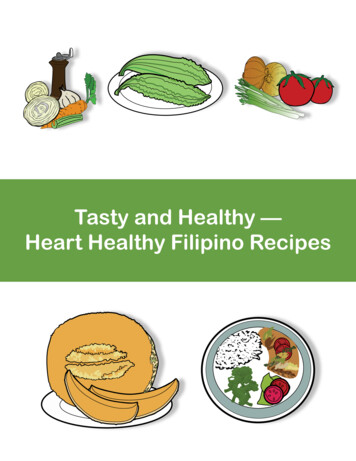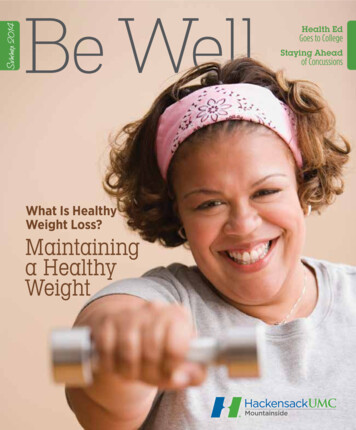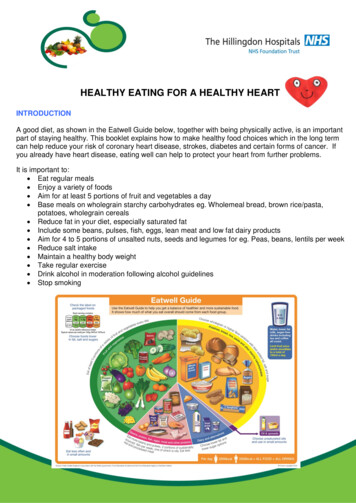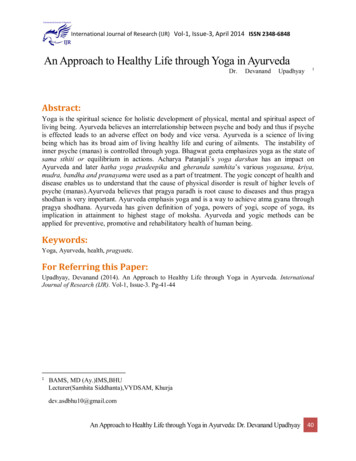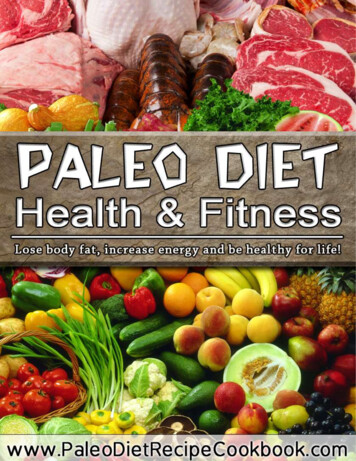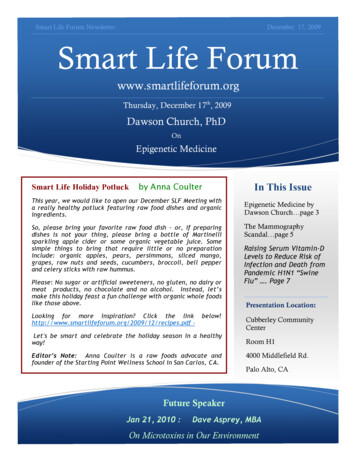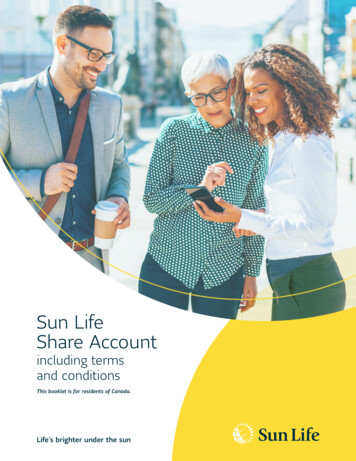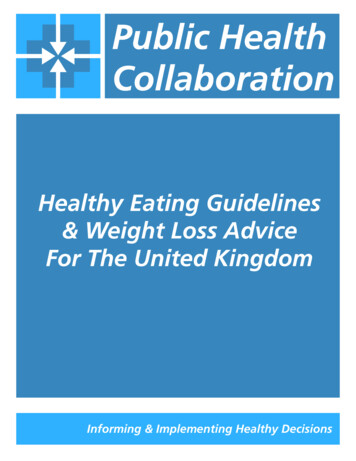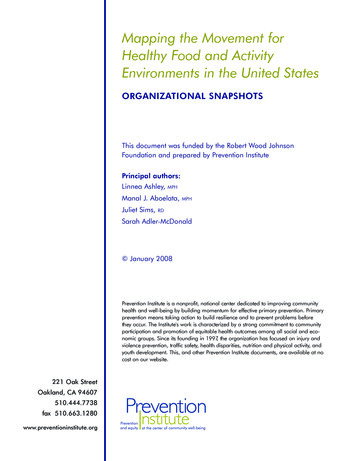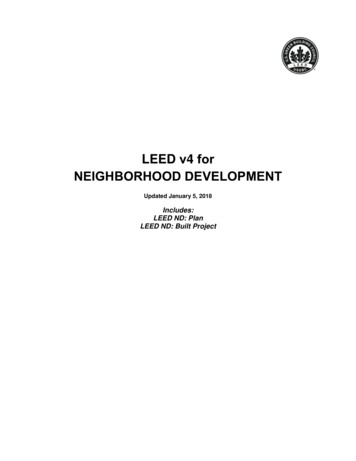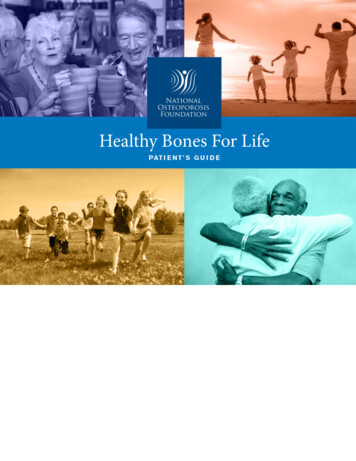
Transcription
Healthy Bones For Life
CONTENTSHealthy Bones for Life Patient’s GuideINTRODUCTIONSECTION 7Healthy Bones for Life . . . . . . . . . . . . . . . . . . . . . . . . . . . . . . . . . . . . . . . . . . . . . . . . . . . . . . . . . . . . . . . . . . . . . . . . . . . . . . . . . . . . . . . 3Bone Mineral Density Test . . . . . . . . . . . . . . . . . . . . . . . . . . . . . . . . . . . . . . . . . . . . . . . . . . . . . . . . . . . . . . . . . . . . . . . . . . .17SECTION 1SECTION 8How Bones Change and Grow. . . . . . . . . . . . . . . . . . . . . . . . . . . . . . . . . . . . . . . . . . . . . . . . . . . . . . . . . . . . . . . . . . . . . . 5Understanding the BMD Test . . . . . . . . . . . . . . . . . . . . . . . . . . . . . . . . . . . . . . . . . . . . . . . . . . . . . . . . . . . . . . . . . . . 19SECTION 2SECTION 9Strong Bones are Important Starting at an Early Age. . . . . . . . . . . . . . . . . . . . . . . 7Exercise . . . . . . . . . . . . . . . . . . . . . . . . . . . . . . . . . . . . . . . . . . . . . . . . . . . . . . . . . . . . . . . . . . . . . . . . . . . . . . . . . . . . . . . . . . . . . . . . . . . . . . . . . . . . . . . . . . 21SECTION 3SECTION 10What is Osteoporosis? . . . . . . . . . . . . . . . . . . . . . . . . . . . . . . . . . . . . . . . . . . . . . . . . . . . . . . . . . . . . . . . . . . . . . . . . . . . . . . . . . . . . . . . 9What Happens Next? . . . . . . . . . . . . . . . . . . . . . . . . . . . . . . . . . . . . . . . . . . . . . . . . . . . . . . . . . . . . . . . . . . . . . . . . . . . . . . . . . . . . . 26SECTION 4SECTION 11Who Gets Osteoporosis? . . . . . . . . . . . . . . . . . . . . . . . . . . . . . . . . . . . . . . . . . . . . . . . . . . . . . . . . . . . . . . . . . . . . . . . . . . . . . . 11Treating Osteoporosis . . . . . . . . . . . . . . . . . . . . . . . . . . . . . . . . . . . . . . . . . . . . . . . . . . . . . . . . . . . . . . . . . . . . . . . . . . . . . . . . . . . . 30SECTION 5SECTION 12What is Low Bone Mass? . . . . . . . . . . . . . . . . . . . . . . . . . . . . . . . . . . . . . . . . . . . . . . . . . . . . . . . . . . . . . . . . . . . . . . . . . . . . . 13Participating in Clinical Trials. . . . . . . . . . . . . . . . . . . . . . . . . . . . . . . . . . . . . . . . . . . . . . . . . . . . . . . . . . . . . . . . . . . 36SECTION 6SECTION 12What Women and Men Need to Know . . . . . . . . . . . . . . . . . . . . . . . . . . . . . . . . . . . . . . . . . . . . . . . 15Resources . . . . . . . . . . . . . . . . . . . . . . . . . . . . . . . . . . . . . . . . . . . . . . . . . . . . . . . . . . . . . . . . . . . . . . . . . . . . . . . . . . . . . . . . . . . . . . . . . . . . . . . . . . . . . . 38Healthy Bones For Life Patient’s Guide National Osteoporosis Foundation, 2014Page 2 of 39
INTRODUCTIONHealthy Bones For LifeOBJECTIVEThis training guide will help you: Understand what osteoporosis is doing to your body. Understand what treatment will do for you, your health andyour future. Understand the positive benefits of the treatment plan and itseffect on your future. Build your confidence in treating this disease. Identify sources of support throughout the course of treatment.Healthy Bones For Life Patient’s Guide National Osteoporosis Foundation, 2014
INTRODUCTIONHealthy Bones For LifeINTRODUCTIONWhether you have osteoporosis, have had a broken bone or are just interested in keeping your bones healthy, the time is right to take charge of your health. It’s time to havea conversation with the members of your healthcare team about keeping your skeletonstrong and improving your bone health.GOALBone loss changes your body and your life.Your skeleton, which supports your body and protects your internal organs, becomes weaker and is more likely to fracture.Broken bones in the spine can cause height loss, deformity and pain. Hip fractures, the most serious type of brokenbone, can make it difficult to take care of yourself or to walk, and are a leading cause of nursing home admissions.The good news is that osteoporosis and bone loss can be treated and in many cases, fracturescan be prevented.This guide provides an outline for a discussion between you and members of your healthcare team about your skeletalhealth. The goal of this exercise is to help you get the information you need to build a partnership with your healthcareteam and take control of your bone health.AcknowledgmentsThe information in this guide was developed by the National Osteoporosis Foundation (NOF) with the assistance ofAndrea Singer, MD, NOF Clinical Director. Funding support for this guide was provided by educational grants fromNovartis and the Council for Responsible Nutrition.Healthy Bones For Life Patient’s Guide National Osteoporosis Foundation, 2014Go to Table of ContentsPage 4 of 39
SECTION 1How Bones Change and GrowOBJECTIVEBy the end of Section 1, patients will be able to: Briefly describe the bone growth cycle throughout life. Identify the period of life when bones are the most dense.Healthy Bones For Life Patient’s Guide National Osteoporosis Foundation, 2014
SECTION 1How Bones Change and GrowKEY POINTSBONE GROWTH & LOSS1. Bones are living tissue and are constantly changing.From the moment of birth until young adulthood, bones are growingand strengthening. This process is called “modeling”.2. Bones are made up of three major components thatmake them both flexible and strong:SlowLossActiveGrowthRapidLoss Collagen, a protein that gives bones a flexible framework.LessRapidLoss Calcium-phosphate mineral complexes that make bones hardand strong. Living bone cells that remove and replace weakenedsections of bone.3. Children and teenagers form new bone faster thanthey lose old bone.In fact, even after they stop growing taller, young people continue tomake more bone than they lose. This means their bones get denseruntil they reach what experts call peak bone mass. This is the pointwhen you have the greatest amount of bone you will ever have. Itusually happens between the ages of 18 and 25 years.4. Old bone cells are replaced on an ongoing basis, aprocess known as “remodeling”.After the active skeletal growth phase in youth, and after menopausein women (a bit later in men), the remodeling process becomesunbalanced and we begin to lose more bone than we replace.This results in a net decrease in the total amount of bone. Whenthe amount of bone loss decreases, it is called low bone density(osteopenia) or osteoporosis. Get enough calcium & vitamin D,exercise regularly, and make healthy lifestyle choices.Healthy Bones For Life Patient’s Guide National Osteoporosis Foundation, 2014102030405060Go to Table of Contents70809Page 6 of 39
SECTION 2Strong Bones are ImportanOBJECTIVEBy the end of Section 2, patients will be able to: Briefly describe lifestyle requirements for strong bones. Identify nutrients needed by bones for good health.Healthy Bones For Life Patient’s Guide National Osteoporosis Foundation, 2014
SECTION 2Strong Bones are Important Starting at an Early AgeKEY POINTS1. Keeping your bones strong and healthy may not be on the top of your wellness list but it should be!Think of your bones as a savings account. There is only as much bone density in your account as you deposit.2. Healthy habits as a child or teenager can pay off years later with stronger bones. Young people can build their bones by eating calcium-rich foods, getting enough vitamin D (through sunshine ordiet), and exercising regularly. The U.S. government publishes Dietary Guidelines for Americans as well as Physical Activity Guidelines forAmericans with the intent of helping citizens develop positive lifestyle habits to prevent chronic disease onset.3. Get enough calcium & vitamin D, exercise regularly, and make healthy lifestyle choices.Healthy Bones For Life Patient’s Guide National Osteoporosis Foundation, 2014Go to Table of ContentsPage 8 of 39
SECTION 3What is Osteoporosis?OBJECTIVEBy the end of Section 3, patients will be able to: State that osteoporosis is a very common condition. Briefly describe the relationship between osteoporosis and brokenbones or fractures.Healthy Bones For Life Patient’s Guide National Osteoporosis Foundation, 2014
SECTION 3What is Osteoporosis?KEY POINTS1. Osteoporosis is a condition in which the bonesbecome weak and can break more easily.2. The term osteoporosis literally means “porous bone.”3. Bone loss is a natural part of aging, but not everyonewill lose enough bone density to develop osteoporosis.Normal BoneOsteoporosis BoneHowever, the older you are, the greater your chance of havingosteoporosis.4. About 9 million Americans over the age of 50 yearshave osteoporosis.5. One half of women and two in five men will developosteoporosis during their lifetime.6. Osteoporosis is the underlying cause of approximately2 million fractures every year.7. Back pain, caused by changes in the vertebrae, may bethe first sign that something is wrong.Healthy Bones For Life Patient’s Guide National Osteoporosis Foundation, 2014Go to Table of ContentsPage 10 of 3
SECTION 4Who Gets Osteoporosis?OBJECTIVEBy the end of Section 4, patients will be able to: List a minimum of three risk factors for developing osteoporosisthat cannot be changed. List a minimum of three risk factors for developing osteoporosisthat can be changed.Healthy Bones For Life Patient’s Guide National Osteoporosis Foundation, 2014
SECTION 4Who Gets Osteoporosis?KEY POINTS1. Begins in childhood via failure to reachpeak bone mass.2. It is not gender specific: A man older than 50 is more likely to break abone due to osteoporosis than he is to getprostate cancer.4. It can be affected by: Poor diet, lack of exercise, smoking and drinkingtoo much.5. Certain medical conditions can also be arisk factor A woman’s risk of breaking a hip due toosteoporosis is equal to her combined risk ofbreast, ovarian and uterine cancer.3. Genetics play a role and so does raceand ethnicity.RISKSRisks you cannot change:Risks you may be able to change: Female gender / past menopause. Woman with estrogen deficiency. Family member with osteoporosis and/ or fractures. Thin, small or petite body frame. Too little intake of calcium, vitamin D andother nutrients. Aging, for both genders. Too little exercise. Other health conditions like rheumatoid arthritis, celiacdisease, overactive thyroid gland. Smoking or past history of smoking. History of a broken bone (fracture). Excessive intake of coffee, cola or othercaffeinated beverages. Use of certain medicines like corticosteroids,anticonvulsants or others. Three or more alcoholic drinks per day. History of falls over the past year.Healthy Bones For Life Patient’s Guide National Osteoporosis Foundation, 2014Go to Table of ContentsPage 12 of 3
SECTION 5What is Low Bone Mass?OBJECTIVEBy the end of Section 5, patients will be able to: Explain the significance of low bone mass. Discuss at least one approach for treating low bone mass.Healthy Bones For Life Patient’s Guide National Osteoporosis Foundation, 2014
SECTION 5What is Low Bone Mass?KEY POINTSLOW BONE MINERAL DENSITY1. Low bone mass is when your bone density is lowerthan normal, but not low enough to be consideredosteoporosis.9.8%2. Low bone mass (osteopenia) does not always meanyou will get osteoporosis, but it is a risk.38.6%3. Approximately 48 million Americans over the age of50 years have low bone mass.4. As we age, we lose more bone than we replace.5. As with osteoporosis, there are no physical symptoms.Low bone mass can progress to osteoporosis, but with changes in dietand exercise, you can slow the bone loss.51.7%6. Individuals with low bone mass have a greater chanceof developing osteoporosis if they lose bone in thefuture because they have less bone to lose.7. People with low bone density are more likely to break abone compared to people with normal bone density.Normal8. If you have low bone mass, your doctor will evaluateyou to see if you need medication.OsteoporosisHealthy Bones For Life Patient’s Guide National Osteoporosis Foundation, 2014OsteopeniaGo to Table of ContentsPage 14 of 3
SECTION 6What Women and Men NeOBJECTIVEBy the end of Section 6, patients will be able to: Identify a minimum of two gender-based facts about osteoporosisor low bone density.Healthy Bones For Life Patient’s Guide National Osteoporosis Foundation, 2014
SECTION 6What Women and Men Need to KnowWHAT WOMENNEED TO KNOW1. Low estrogen levels lead to bone loss Estrogen is a hormone that helps protect bone.2. All women go through menopause and it leads to lower estrogen levels, which causebone loss.3. Women’s bones are generally thinner than men’s & bone density has a rapid decline fora time after menopause.4. Osteoporosis starts earlier and gets worse faster in women because of midlifehormonal shifts.5. Women can lose up to 20% of their bone density in the 5-7 years after menopause.6. 80% of Americans with osteoporosis are women.WHAT MENNEED TO KNOW1. Osteoporosis is associated with some male-only conditions: For example, abnormally low testosterone levels (hypogonadism). Low testosterone levels put men at risk.2. Men who break a hip or wrist are less likely than women to get treated for osteoporosis.3. Men may, however, have fewer treatment choices at this time because some drugs havebeen tested only in women.4. Starting at about age 65, both sexes lose bone at about the same rate.Healthy Bones For Life Patient’s Guide National Osteoporosis Foundation, 2014Go to Table of ContentsPage 16 of 3
SECTION 7Bone Mineral Density TestOBJECTIVEBy the end of Section 7, patients will be able to: Describe how bone density is measured. List at least two reasons for a bone density test to be performed.Healthy Bones For Life Patient’s Guide National Osteoporosis Foundation, 2014
SECTION 7Bone Mineral Density TestKEY POINTS1. What is it? Measures the density of minerals, like calcium andother types in your bone.3. How is this performed? Dual-energy x-ray absorptiometry (DXA) scan. Painless. Peripheral dual-energy x-ray absorptiometry(pDXA). May be able to remain fully clothed. Quantitative ultrasound (QUS). Takes less than 15 minutes. Quantitative Computed Tomography (QCT)2. How is this important? Diagnose bone loss and osteoporosis. Shows how well osteoporosis medicine is working. pQCT (peripheral QCT) scan. Radiographic absorptiometry (RA). Single energy x-ray absorptiometry (SXA). Predict risk of future bone fractures.Healthy Bones For Life Patient’s Guide National Osteoporosis Foundation, 2014Go to Table of ContentsPage 18 of 3
SECTION 8Understanding the BMD TOBJECTIVEBy the end of Section 8, patients will be able to: Understand how BMD tests are interpreted. Discuss why Z-scores are performed.Healthy Bones For Life Patient’s Guide National Osteoporosis Foundation, 2014
SECTION 8Understanding the BMD TestKEY POINTST-SCORE BONE MINERAL DENSITYT-score Your test result will be compared to the ideal or peak bone mineraldensity of a healthy 30 year old adult. Differences between your BMD and that of a healthy adult aremeasured in standard deviations (SD).0 The more standard deviations your score is below 0, the lower yourBMD and higher your risk of fracture. The greater the negative number, the more severe the bone loss. 1to -1-1.0Osteopenia-2.5Osteoporosis Some fractures, especially hip and spine fractures are almostalways due to osteoporosis regardless of the T-score.Z-scoreNormal Bones-1.0 to -2.5-2.5 or lower Used to evaluate BMD in children and adolescents. Also used in adults.fractureSevere Osteoporosis-2.5 or lower fracture Compares a person’s BMD to what is expected in another personof the same age and body size. Useful for determining whether an underlying disease or conditionis causing bone loss.Healthy Bones For Life Patient’s Guide National Osteoporosis Foundation, 2014Go to Table of ContentsPage 20 of 3
SECTION 9ExerciseOBJECTIVEBy the end of Section 9, patients will be able to: Discuss the benefits of exercise for skeletal health. List safety considerations for exercise by people with osteoporosis.Healthy Bones For Life Patient’s Guide National Osteoporosis Foundation, 2014
SECTION 9ExerciseKEY POINTS1. Like your muscles, your bones get stronger when you make them work.2. This means handling impact, weight of your body or more resistance.3. Exercise will help increase or maintain bone strength & improve ability to dodaily activities.4. Always check with your healthcare provider to find out what exercises are safe for you.WEIGHT-BEARINGEXERCISESWeight-bearing exercises include activities that make you move against gravity while beingupright, such as fast walking.Higher impact exercises like jogging and running may not be safe if you have osteoporosis ora history of fracture.Try to do 30 minutes of weight-bearing exercise, moderate pace, most days of the week.When you do muscle-strengthening exercises, you move your body, a weight, or some otherresistance against gravity.Muscle-strengthening exercises include lifting weights, using elastic exercise bands or using weight machines. They arealso called resistance exercises.Aim to perform 8-12 different muscle-strengthening exercises to cover main body areas.1-2 sets of 8-10 repetitions to fatigue, for 2-3 days per week.Healthy Bones For Life Patient’s Guide National Osteoporosis Foundation, 2014Go to Table of ContentsPage 22 of 3
SECTION 9POSTUREEXERCISEExercise Good posture is important. Can minimize kyphosis and reduce the risk of broken bones in the spine. Try to work on good posture several times a day.BALANCEEXERCISE Can reduce your chance of falls & broken bones. Should be challenging, but safety is the first priority.FPOHealthy Bones For Life Patient’s Guide National Osteoporosis Foundation, 2014Go to Table of ContentsPage 23 of 3
SECTION 9How Bones Change and GrowBALANCE EXERCISEWide StanceNormal StanceNarrow StanceSingle limb*other foot in the l tandem** Use extreme cautionHealthy Bones For Life Patient’s Guide National Osteoporosis Foundation, 2014Go to Table of ContentsPage 24 of 3
SECTION 9How Bones Change and GrowBALANCE EXERCISEEyes: OpenHead: Focus on an object infront of youArms: Reach out to the sidesShoes: Hard sole shoesSurface: Solid floor (linoleum)Eyes:Head:Arms:Shoes:Surface:Closed*Turn right to leftAt your sidesNo shoesSoft floor (carpet)Eyes:Head:Arms:Shoes:Surface:Closed*Tilt up and downCrossed on your chestSoft sole shoesCompliant surface(pillow, foam, balance disc*)* Use extreme cautionHealthy Bones For Life Patient’s Guide National Osteoporosis Foundation, 2014Go to Table of ContentsPage 25 of 3
SECTION 10What Happens Next?OBJECTIVEBy the end of Section 10, patients will be able to: List the components of a comprehensive treatment planfor osteoporosis. State the recommended daily intake of calcium and vitamin D Explain the benefits and risks of medication therapy for patientswith osteoporosis.Healthy Bones For Life Patient’s Guide National Osteoporosis Foundation, 2014
SECTION 10What Happens Next?KEY POINTSDevelop treatment plan including: Medication/ Supplements. Exercises. Healthy Lifestyle. Additional testing. Keeping clinician informed of changes in routineor/ and general health.RECOMMENDEDTREATMENTMedications: Your healthcare provider will consider otherhealth problems you have when recommendinga medicine.Calcium recommendations: ensure you are getting enough.Vitamin D: helps absorb calcium & makenew bone: To get enough vitamin D, many people need to takea supplement.Healthy Bones For Life Patient’s Guide National Osteoporosis Foundation, 2014Exercise (role & safe modifications):Adhere to the U.S. Physical Activity Guidelinesfor Americans: Weight-bearing. Balance training.Nutrition: Adhere to the U.S. Dietary Guidelinesfor Americans.Lifestyle issues: Smoking cessation, limit alcohol.Go to Table of ContentsPage 27 of 3
SECTION 10CALCIUM &VITAMIN DSUPPLEMENTATIONWhat Happens Next?Calcium is an essential nutrient because it provides thebuilding material for building new bone.Try to get your daily amount of calcium from your diet first and only takesupplements to make up the shortfall.Consider foods that have calcium added. Ex: somebrands of cereal & juices.CALCIUM & VITAMIN D FOR WOMEN: Under age 50 need 1,000 mg of calcium & 400-800 IUsof vitamin D daily. Age 50 and older need 1,200 mg of calcium & 800-1,000IUs of vitamin D daily.Try some healthy alternatives: Add beans to soups, chili, and pasta dishes. Enjoy a smoothie made with yogurt. Include leafy vegetables in your meals.Your body needs vitamin D to absorb calcium.It is very difficult to get enough of vitamin D from food alone, somany people will need to take a vitamin D supplement (note:most calcium supplements also contain vitamin D) to obtain theirrecommended amount.CALCIUM & VITAMIN D FOR MEN: Under age 50 need 1,000 mg of calcium & 400-800 IUof vitamin D daily. 50-70 need 1,000 mg of calcium & 800-1,000 IU ofvitamin D daily. 71 and older: need 1,200 mg of calcium & 800-1,000 IUof vitamin D daily.Fatty fish (e.g. salmon, tuna and mackerel) and fish liver oils are the bestsources, while beef liver, cheese and egg yolks contribute small amounts.Milk in the U.S. is fortified with 100 IU of vitamin D per 8 ounce serving.Your body naturally makes vitamin D with prolongedsun exposure.However, use of sunscreen with an SPF of 15 or greater impairsthis action.Ask your physician to recommend a vitamin Dsupplement if needed.Healthy Bones For Life Patient’s Guide National Osteoporosis Foundation, 2014Go to Table of ContentsPage 28 of 3
SECTION 10What Happens Next?CREATING THATHEALTHYLIFESTYLEDODO NOT Eating calcium-rich foods can help your bones nomatter what age. Salty foods (canned soups and processed meats)can decrease your bone’s calcium reserves. Consume the equivalent of 3 8-ounce glassesof low-fat or non-fat milk per day to get enoughcalcium and other nutrients. Excess caffeine (i.e. more than three cups ofcoffee a day) can also decrease your bone’scalcium reserves. Consume foods rich in vitamin D (e.g. fatty fish)and/ or ask your doctor about taking a vitamin Dsupplement. Excessive alcohol intake can lead to bone loss. Leafy green vegetables also provide calcium,magnesium and other essential nutrients that helpmaintain good bone health.VITAMIN D RICH FOODSPercentage of daily value32%42%17%2%BroccoliHealthy Bones For Life Patient’s Guide3%Spinach Ice Cream National Osteoporosis Foundation, 2014MilkCheeseFishYogurtGo to Table of ContentsPage 29 of 3
SECTION 11Treating OsteoporosisOBJECTIVEBy the end of Section 11, patients will be able to: Explain the benefits of medication therapy for patients withosteoporosis. Explain the potential risks associated with medication therapyfor patients with osteoporosis and fractures.Healthy Bones For Life Patient’s Guide National Osteoporosis Foundation, 2014
SECTION 11Treating OsteoporosisKEY POINTS1. While there is no cure, there are steps you can take to slow or stop the progress ofosteoporosis or prevent fractures (broken bones).In some cases, your bones may even improve.2. If you have osteoporosis or low bone density, you should talk to your healthcare providerabout whether you need treatment at this time.ANABOLICMEDICINEStimulates yourbody to make newbone more quicklyIncreases yourbone densityTeriparatide (parathyroid hormone or PTH): Use in men and women at high risk for fracture. Reduces fractures at spine and non-spine sites. Give by daily injection for a maximum of 24 months. Side effects include leg cramps, nausea, and dizziness.Lowers your risk ofbreaking bonesHealthy Bones For Life Patient’s Guide National Osteoporosis Foundation, 2014Go to Table of ContentsPage 31 of 3
SECTION 11ANTIRESORPTIVEMEDICINESSlow the breakdownof boneMaintain or improvebone densityLower the risk ofbreaking boneTreating OsteoporosisBisphosphonate medicines: Reduce bone loss.Estrogen agonist/antagonist medicines(SERMs) (women only): Increase bone density in the hip and spine. Increase bone density in the hip and spine. Reduce the risk of fractures in the spine, hip andother non-spine sites. Prevent bone loss. Side effects may include heartburn, nausea,abdominal pain, bone or muscle pain. Side effects may include hot flashes, leg cramps,increased risk of blood clots. Can be given orally (pill) or intravenously.Rank ligand (RANKL) inhibitor: Slow bone breakdown. Increase bone density in the hip and spine. Reduce the risk of fractures in the spine, hip andother non-spine sites. Given as a subcutaneous injection twice a year. Side effects include: Low levels of calcium in theblood, risk of serious skin infections (cellulitis) andskin rash.Calcitonin: Use only when other medicines are not able tobe used. May reduce the chance of spinal fractures. Give by nasal spray or daily injection. Side effects include runny nose, bleeding from thenose and allergic reactions.Healthy Bones For Life Patient’s Guide National Osteoporosis Foundation, 2014 Reduce the risk of spinal fracture.Estrogen therapy, hormone therapy andTissue-Selective Estrogen Complex(women only): Use in early menopause to control menopausalsymptoms and hot flashes; will help preservebone density. Primary indication for use is treatment ofmenopausal symptoms. Tissue-Selective Estrogen Complex is acombination of estrogen and bazedoxifene, aSERM, and is used in women who suffer frommoderate-to-severe hot flashes (vasomotorsymptoms) associated with menopause and toprevent osteoporosis after menopause. Side effects include: muscle spasms, nausea,diarrhea, dyspepsia, upper abdominal pain,oropharyngeal pain, dizziness, neck pain, andincreased risk of blood clot.Go to Table of ContentsPage 32 of 3
SECTION 11OSTEOPOROSISDRUGSTreating OsteoporosisTHE RISK OF TAKINGBONE STRENGTHENING MEDICATIONBenefits: For every 100 women taking bisphosphonates for threeyears, six will avoid a fracture.Out of 1,000 people on osteoporosis medication for 5 years:Less than 1may have a jaw problem (.01/ 1000)Less than 1 may have a rare treatment related fracture (.16/ 1000) The protection is best for fractures of the spine (1 in 20women), but is also significant for hip fractures (1in 100).Risks Long term treatment of osteoporosis withbisphosphonates, particularly for more than five years,has been linked to some side effects, including atypicalfemur fracture. Osteonecrosis of the jaw (ONJ) is a very rare conditionthat has been associated with long term, high dosebisphosphonate therapy. The condition is more commonin people with poor dental hygiene and in those who arereceiving high doses to treat bone loss associated withcancer and cancer treatment.Healthy Bones For Life Patient’s Guide National Osteoporosis Foundation, 2014Go to Table of ContentsPage 33 of 3
SECTION 11ADHERENCEISSUESTreating OsteoporosisYOUR RISK OF FRACTUREWhat happens if I do not treat osteoporosis? Your risk of fractures will increase.Out of 1,000 women, 500 will suffer a fracture withouttreatment for Osteoporosis. You may have loss of height due to fractures inthe vertebrae. Spinal fractures may cause a curving deformity ofthe spine. Severe back pain due to vertebral fractures or changesin posture may occur. Fractures from osteoporosis may cause temporary orpermanent loss of mobility and independence. Internal body organs, like the lungs, stomach andintestines may be squeezed for space in the chestand abdomen as the bones in the spine collapsefrom fractures.Healthy Bones For Life Patient’s Guide National Osteoporosis Foundation, 2014Go to Table of ContentsPage 34 of 3
SECTION 11Treating OsteoporosisSAFETY1. Fall prevention: Wear supportive shoes with rubber soles &low heels. Have vision & hearing checked often. Use hand rails on stairs & escalators. Be careful around pets in the home or whenwalking outdoors.2. Fall proof your home: Remove clutter, cords & throw rugs. Keep halls, stairs, and entryways well lit. Use night lights in rooms. Use nonskid rubber mats near the sink, bathtuband in shower.3. Follow guidelines for safe movement;avoid movements that put extra stress onthe spinal bones: Bending forward from waist: sit-ups, abdominalcrunches & toe touches. Twisting trunk & bending forward. Reaching high or far out in front of you.Healthy Bones For Life Patient’s Guide National Osteoporosis Foundation, 20144. Ask your health care provider if anymedicines you take could cause you to feeldizzy or lose balance.5. Each year 1/3 of all persons over age 65will fall and many cause broken bones.6. Knowing how to move, sit and standproperly can help you stay active whileavoiding broken bones.7. People with osteoporosis or who have anincreased risk of breaking a bone shouldavoid the following positionsor movements: Having a slumped, head-forward posture. Twisting the trunk and bending forward when doingactivities such as coughing, sneezing, vacuumingor lifting. Anything that requires you to reach high or far infront of you. An example is stretching forward toreach into the trunk of your car to get groceries orother items.Go to Table of ContentsPage 35 of 3
SECTION 12Participating in Clinical TrOBJECTIVEBy the end of Section 12, patients will be able to: List possible benefits of participating in clinical trials.Healthy Bones For Life Patient’s Guide National Osteoporosis Foundation, 2014
SECTION 12Treating OsteoporosisKEY POINTS Clinical trials involve research using human volunteers that are intended to add tomedical knowledge.Participants receive specific treatments according to the research plan created by the investigators. These treatmentsmay be medical pr
Bone loss changes your body and your life. Your skeleton, which supports your body and protects your internal organs, becomes weaker and is more likely to fracture. Broken bones in the spine can cause height loss, deformity and pain. Hip fractures, the most serious type of bro
